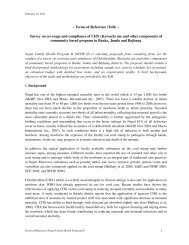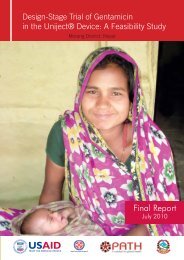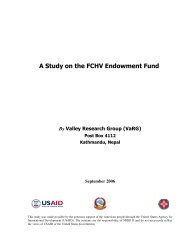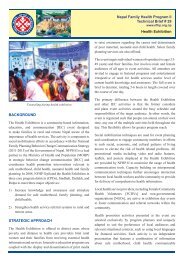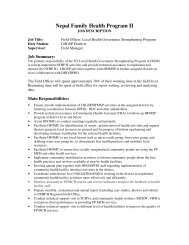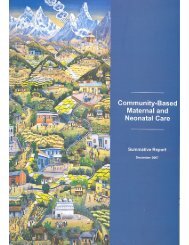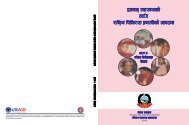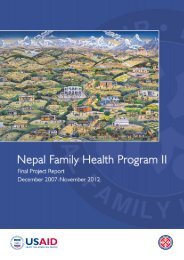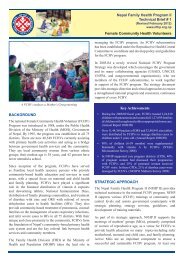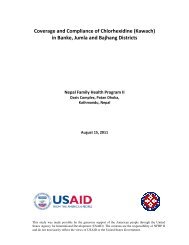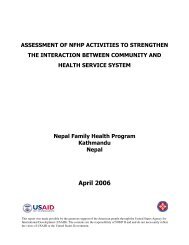(Kawach) in Banke, Jumla and Bajhang Districts - Nepal Family ...
(Kawach) in Banke, Jumla and Bajhang Districts - Nepal Family ...
(Kawach) in Banke, Jumla and Bajhang Districts - Nepal Family ...
Create successful ePaper yourself
Turn your PDF publications into a flip-book with our unique Google optimized e-Paper software.
Most of the RDW <strong>in</strong> <strong>in</strong>stitutional deliveries did not know about the tim<strong>in</strong>g of when the cord<br />
was cut because the newborns were h<strong>and</strong>led by the health workers. The distribution of RDW<br />
who delivered at home shows wide variation <strong>in</strong> the tim<strong>in</strong>g of cord-cutt<strong>in</strong>g across districts. In<br />
particular, <strong>Banke</strong> shows the highest delay <strong>in</strong> cutt<strong>in</strong>g the cord, i.e., more than 38 percent<br />
reported that their newborn’s umbilical cord was cut after more than one hour (<strong>and</strong> up to 14<br />
hours). The delay <strong>in</strong> cutt<strong>in</strong>g the cord is because of the cultural practice that requires wait<strong>in</strong>g<br />
for a member of the occupational caste<br />
group called ‘Baskhor<strong>in</strong>’ <strong>and</strong><br />
‘Chamayan’ for cutt<strong>in</strong>g the cord. In<br />
<strong>Jumla</strong>, almost 44 percent had their<br />
newborn’s umbilical cord cut with<strong>in</strong><br />
five m<strong>in</strong>utes of birth. In <strong>Bajhang</strong>,<br />
almost one-third had cut the umbilical<br />
cord with<strong>in</strong> five m<strong>in</strong>utes <strong>and</strong> another<br />
one-third had cut it between 6-15<br />
m<strong>in</strong>utes after the birth (Table 5).<br />
2.4 Application of Substance on Umbilical Cord Stump<br />
Table 5 : Percent distribution of RDW by tim<strong>in</strong>g of cutt<strong>in</strong>g the<br />
umbilical cord of the newborn among home delivery<br />
Tim<strong>in</strong>g of cutt<strong>in</strong>g umbilical<br />
cord <strong>Banke</strong> <strong>Jumla</strong> <strong>Bajhang</strong><br />
With<strong>in</strong> 5 m<strong>in</strong> 13.4 43.9 35.4<br />
6-15 m<strong>in</strong> 14.7 29.5 34.0<br />
16-60 m<strong>in</strong> 26.4 17.3 24.2<br />
More than 1 Hour 38.1 0.5 1.2<br />
Do not know 7.4 8.8 5.2<br />
Median m<strong>in</strong>utes 60 7 10<br />
Total (n) 299 387 421<br />
Table 6 shows the practice of apply<strong>in</strong>g<br />
substances on the cord stump of those<br />
newborn who were delivered at home.<br />
A majority of RDW <strong>in</strong> all three<br />
districts reported that someth<strong>in</strong>g was<br />
applied to the cord stump of the<br />
newborn. A significantly high<br />
proportion of RDW <strong>in</strong> <strong>Bajhang</strong> (34%)<br />
<strong>and</strong> <strong>Jumla</strong> (24%) compared to <strong>Banke</strong><br />
(9%) reported that they had not applied<br />
anyth<strong>in</strong>g to their newborns’ cord<br />
stumps.<br />
Table 6: Percent distribution of RDW by substance used on cord<br />
stump of the newborn among home delivery<br />
<strong>Banke</strong> <strong>Jumla</strong> <strong>Bajhang</strong><br />
Types of Substance applied #<br />
Noth<strong>in</strong>g 9.0 23.5 33.7<br />
<strong>Kawach</strong> 72.9 55.8 38.2<br />
Oil 14.4 14.0 1.4<br />
Other medic<strong>in</strong>es (powder/o<strong>in</strong>tment) 5.7 8.5 3.6<br />
Turmeric/Turmeric powder 2.7 12.7 0.7<br />
Ghee or Butter (nauni) 0.0 0.0 22.8<br />
Others 1 0.7 0.3 0.5<br />
Total (n) 299 387 421<br />
1 Others <strong>in</strong>clude cotton, herbs, s<strong>in</strong>door, <strong>and</strong> ash.<br />
# Multiple response<br />
Among RDW who stated that someth<strong>in</strong>g was applied <strong>in</strong> the cord, a majority reported the<br />
application of <strong>Kawach</strong> to their children’s cord stumps. In <strong>Banke</strong> <strong>and</strong> <strong>Bajhang</strong>, after <strong>Kawach</strong>,<br />
oil was the second most frequently used substance on a child’s umbilical cord stump, as cited<br />
by 14 percent of the respondents <strong>in</strong> each district. The practice of us<strong>in</strong>g turmeric powder was<br />
also common <strong>in</strong> <strong>Jumla</strong>. On the other h<strong>and</strong>, <strong>in</strong> <strong>Bajhang</strong>, nearly a quarter reported apply<strong>in</strong>g<br />
ghee or butter (nauni) to the cord stump<br />
(Table 6).<br />
2.5 Accessibility of <strong>Kawach</strong><br />
To assess the coverage of <strong>Kawach</strong>, RDW were<br />
asked if they had received <strong>Kawach</strong> dur<strong>in</strong>g<br />
their pregnancy with their last child. Figure 1<br />
shows that a little over half RDW <strong>in</strong> <strong>Banke</strong><br />
received <strong>Kawach</strong> dur<strong>in</strong>g their last pregnancy<br />
period. The proportion of RDW who received<br />
<strong>Kawach</strong> was lesser <strong>in</strong> <strong>Jumla</strong> (40%) <strong>and</strong><br />
<strong>Bajhang</strong> (38%). Among those who received<br />
11<br />
Percent<br />
100<br />
90<br />
80<br />
70<br />
60<br />
50<br />
40<br />
30<br />
20<br />
10<br />
0<br />
Figure 1: Proportion of RDW who had received <strong>Kawach</strong><br />
dur<strong>in</strong>g their last pregnancy<br />
52<br />
40 38<br />
<strong>Banke</strong> (n=596) <strong>Jumla</strong> (n=583) <strong>Bajhang</strong> (n=594)



